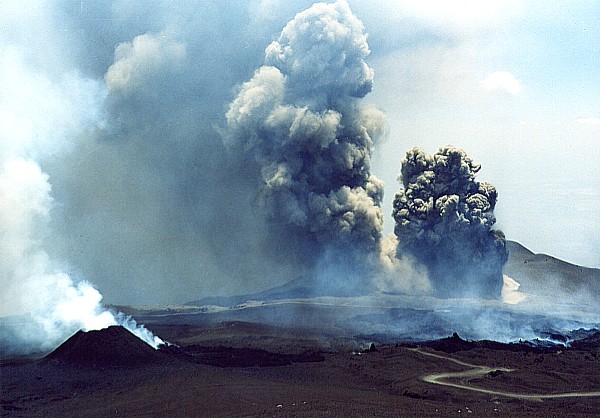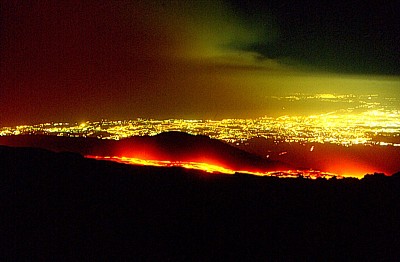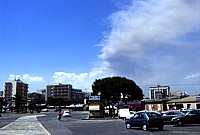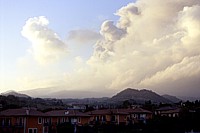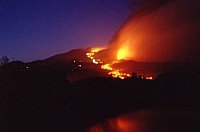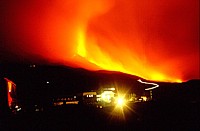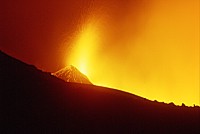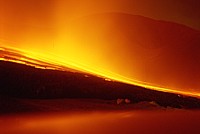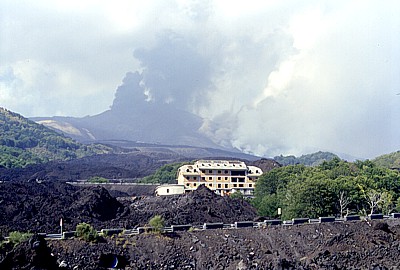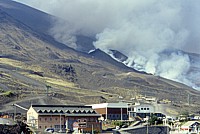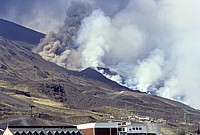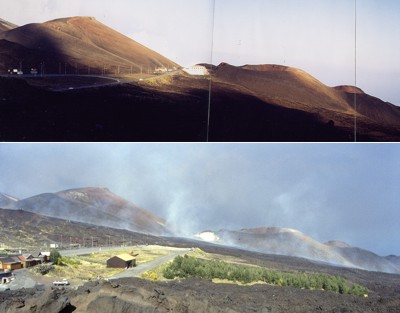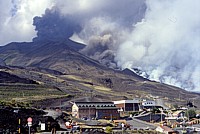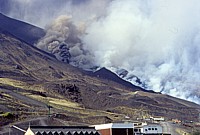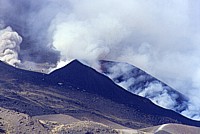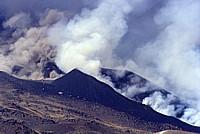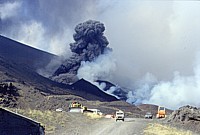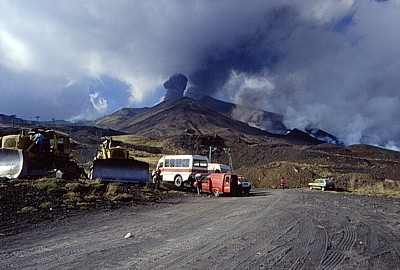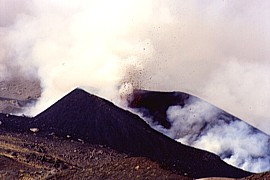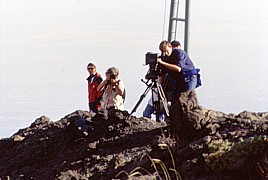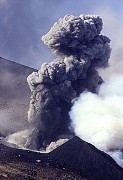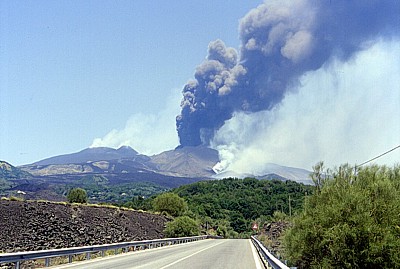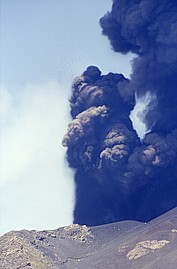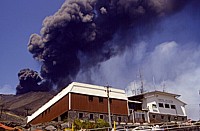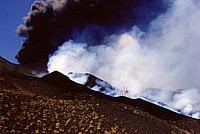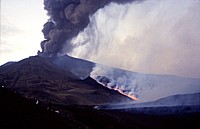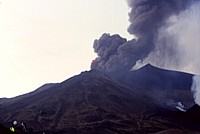| Etna
index |
||
| Geology | Geological history | Cones and craters |
| Eruptive characteristics | Eruptions before 1971 | Eruptions since 1971 |
| Etna and Man | References | Web sites |
| Weather forecasts | FAQ | Latest news |
Etna
photo gallery: 2001
Etna makes the news
![]()
Part 2: Flank eruption, 17 July - 9 August 2001
Together with a team of German journalists we approach Nicolosi and then proceed to the area of the Rifugio Sapienza, where frantic work is under way to salvage the tourist infrastructures from lava flows that spill down along the ski track and the cable car from the eruptive vents at 2700 m elevation. Only a few hundred meters away, another eruptive fissure at 2100 m elevation pours out a large lava flow that crosses the access road from Zafferana and advances in the direction of Nicolosi. It is hard to believe that this is the same place which I have visited more than 100 times during the previous years, and which has always given an illusion of stability and eternity. Now, everything looks different, and many features I have been familiar with are rapidly transferred into memory, only to be revived when looking at the numerous photographs taken during the past few years.
A
river of molten rock spills down the southern flank of Etna on
the evening of 22 July 2001, in the direction of the densely populated
areas further downslope. We have seen many eruptions on many evenings
in the past years, always with the splendid background of the
lights of Catania and surrounding towns. But those eruptions were
at the summit and did not represent any threat to inhabited areas.
This time the situation is much more dramatic. And above in the
night sky, a dense plume of ash (emitted from the explosive vents
on the Piano del Lago) is drifting southwards, reaching distances
of several hundred kilometers from the volcano |
Scenes from a battlefield, 23-24 July 2001
Returning to the erupting volcano at daylight on 23 July 2001, the situation becomes clearer to me. What on the previous evening seemed largely a fiery spectacle is now seen to be a peculiar kind of battle - the battle fought by the owners of the tourist facilities around the Rifugio Sapienza against the menacing lava. The impression of war is reinforced by the presence of military, police and by the continuous detonations produced at the eruptive vents. So far, the eruption has only caused little damage (the access road from Zafferana has been interrupted by a lava flow), but the continued advance of lava from eruptive vents located higher upslope directly threatens some of the tourist installations, most of all the cable car, which had already been destroyed twice by eruptions, in 1971 and 1983. And if things hadn't been enough already, yet another eruptive fissure (the seventh) opens on the southeastern flank of the Southeast Crater cone, emitting a small lava flow
At
times, one can see strange coincidences of strikingly different
stories in a single image. This photograph, taken on the morning
of 23 July 2001, shows eruptive activity at two sites on the southern
flank of Etna in the background (2570 and 2100 m), and the lava
flow of the 1983 eruption in the foreground, which affected a similar
area. That flow buried many buildings in its path (actually, the
1983 eruption was far more devastating than the 2001 eruption),
including one belonging to a catholic order that possesses large
areas of land on the southern flank of the volcano. During the late-1990s
a new building (seen in the center of this image) was raised in
the same spot, but construction was prohibited just when the building
was about to be finished. The reason: this new building was much
larger than the pre-1983 structure. Reconstruction is allowed in
exactly the same place where a building has once stood, but the
new building may not be larger than the previous one. This is one
remarkable example of how things work in Sicily - many buildings
are constructed without authorization, and often construction is
stopped in the last moment. Some are later finished (after some
mysterious kind of agreement is found), but many remain as unfinished
skeletons in the middle of the landscape or within towns |
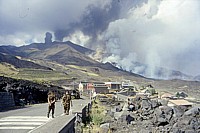 |
Scenes like from a war can be seen on 23 July 2001 at the tourist complex of Rifugio Sapienza (some of the buildings are visible in the left-hand photograph). Eruptive activity is in full swing at |
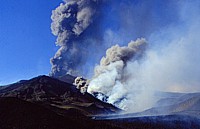 |
Nearly
twelve years lie between these two photographs taken from nearly
identical positions and showing the impressive chain of pyroclastic
cones of the Monti Silvestri, close to the tourist station of Rifugio
Sapienza. The upper photograph (which is actually a photomosaic)
was taken on 29 September 1989, when another (relatively harmless)
flank eruption was under way in the Valle del Leone. Lower photograph,
taken on 23 July 2001, shows the same site under more dramatic circumstances.
A parking lot and the access road from Zafferana have been buried
by the large lava flow issuing from the vents at 2100 m elevation,
and a large restaurant (seen between the two largest of the Monti
Silvestri cones) has narrowly escaped distruction. Yet another section
of the road will be buried under more lava a few days later |
Waiting
for the next assault of the lava: caterpillars are ready to be used
for the construction of earth barriers and deviation channels for
the lava flows that creep down the steep slope above the tourist
complex of the Rifugio Sapienza (a small steam plume above the slope
behind the caterpillars indicates the presence of these flows).
Meanwhile, dark ash plumes are rising above the crest of the Montagnola
(the conspicuous cone in the center of the image), originating at
the phreatomagmatic vents on the Piano del Lago, at 2570 m elevation.
Nearly 500 m further downslope, the lowest of the newly formed eruptive
fissures (2100 m) is visible at extreme right |
Return to the Etna photo gallery
Copyright © Boris Behncke, "Italy's Volcanoes: The Cradle of Volcanology"
Page set up on 23 November 2003; last modified on 6 December 2003

